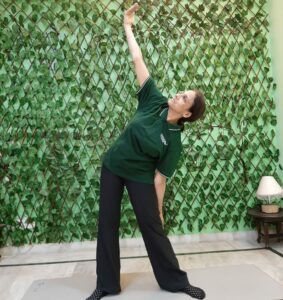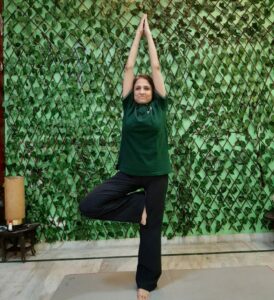–Dr. Loveleena Nadir, Rosewalk hospital
Yoga is derived from Sanskrit root “Yuj” to unite. It signifies unified balance between mind, body and soul. Yoga in pregnancy is a multidimensional physical, mental, emotional & intellectual preparation to deal with challenges of pregnancy. Childbirth is an emotional experience but leaves on feeling delighted, exhilarated & exhausted at the same time.
Yoga assists with emotional regulation, makes women feel more empowered to make choices, helps them develop strong connections with their body, mind and the foetus, enables women to accept and appreciate themselves and increases the skills, confidence, self-efficiency & capping ability to manage pain during labour.
Yoga is a multifaceted approach to exercise that encourages stretching, focused breathing and mental centring to stay calm during labour.
ALSO READ | Yoga Reduces Severity And Induces Remission In Rheumatoid Arthritis: AIIMS Study
Helps to reduce pregnancy challenges like
- Insomnia (improves sleep)
- Fatigue
- Excessive maternal weight gain
- Low back & pelvic pain
- Constipation
- Urinary incontinence
- Risk of gestational diabetes
- Pregnancy induced hypertension
- Depression & anxiety (lowers the cortisol levels)

- Improves individuals ability to adapt to activities related to infant care
- Improves posture & stamina
- Strengthens the muscles of back , abdomen & pelvis resulting in
- Lower rates of induction of labour
- Shorter duration of labour
- Lowered perception of labour pains
- Lower rates of caesarean deliveries (inactive women are 3.7 times likely to have LSCS)
- Lower rates of preterm births
- Ensure delivery at appropriate gestational age. 40% of women have lower risk of preterm birth.
- Enhances nervous system regulation & elevates mood.
- Yoga is contemplative practise which involves
- Physical postures (Asanas)
- Breathing techniques (Pranayam)
- Concentration techniques (Dhyana)
Asanas focus on building strength & balance.
Pranayam makes one aware of one’s breathing & boosts lung function.
Dhyan helps to pay close attention to thoughts & emotions to bring about a state of calm.

Ist Trimester Asanas:
- Utthita Trikonasana (Extended pose): Strengthens the pelvis floor muscles & increases flexibility of spine and improves digestion
- Virabhadrasana (Warrior pose): Strengthens the body & back muscles , increases flexibility and reduces back pain , ones up lower body , stretches the groin area
- Vrikshasana ( Tree pose): Stretches legs, back and arms & helps to improve concentration
ALSO READ | Researchers Find Therapeutic Effects Of Yoga In Depression
2nd trimester:
Of gravity shifts, so do standing poses with heel against the wall for support while twisting, avoid moving waist but move shoulder’s & back
- Vajrasana (thunderbolt)- Improves digestive system & helps to relieve heat burn
- Matsya kridasana – Improves digestion blood circulation & sleep , relieves constipation
- Marjariasana (cat stretch pose) – Strengthens perineal muscles, increases flexibility of neck, spine & shoulders which helps in early crown during labour.
- Tadasana (Mountain pose)- Good for spine & strengthens the rectus –abdominal muscles which is an accessory muscle used for bearing down
- Bhadrasana-(Gracious pose)- Improves digestion , relives mental stress& strengthens pelvic floor muscles
- Katichakrasana (waist rotating pose) – Tones up muscles of waist, back & hips & relieves physical & mental stress.
Third Trimester- Supine poses should be avoided
- Ardhatitaliasana (Half butterfly)- Helps in losing of hip joint & aids childbirth
- Poorna Titali asana (full butterfly)– Strengthens & stretched the perineum & inner thigh muscles
- Chakkichalanasana (Churning mill pose)– Tones up the perineal muscles & helps in preparation of natural birth
- Uttanasana (Squat & rise pose) – Strengthens the muscles of the back & thighs. Widens the pelvic cavity & helps to deliver naturally.
Pranayam – is a practise of complete prolonged & slow breathing. Energises & rejuvenates mind & souls. Gives emotional stability & helps to eliminates anxiety, fear & stress. Improves breathing capacity, stamina & vitality
Anulom vilom pranayama- Designed to hold breath, provide more oxygen to mother & baby & helps in nearing down efforts
Bhramaripranyam – helps to release stress, anger & calms the mind. Makes controlled breathing easier during labour.
Dhyana- Meditation is relaxation technique which helps to focus, increase awareness & calm the mind. Helps create harmony between mind body & soul. Advised to set with spine straight & erect & chant mantra like “OM” for 8-10 mins.

Yoga mudras are hard positions which stimulate various energies in the body.
- Aparna Mudra– helps & deal with pain perception
- Gyan Mudra – calms & purifies the mind
- Aakash mudra- Promotes positivity
- Pushan Mudra- helps to relieve nausea, heartburn & feeling of fullness
- Yoga Bandha– refers to static postures. Involves repetitive constriction of rectal sphincter which helps to strengthens pelvic floor muscles & aids in natural birth. Also prevents urinary leak while coughing ,sneezing or laughing.

Post-natal yoga helps to regain balance, mobility
- Aids muscular recovering
- Helps in post-delivery weight loss
- Calms the mind & helps mother cope up with stress & anxiety
- Restores lung functions & breathing patterns
- Helps & adjust to demands in post-natal period, breast feeding, healing and recovery & sleep deprivation.
Safety guidelines – Before beginning a yoga programme, get your doctor’s approval.











